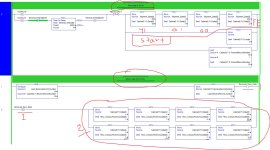Hi, Guys
I'm trying to upgrade a device witch comms is thru a RS232.
The PLC is a Compactlogix L16ER to a remote PIO 1734-AENT then on this PIO a RS232 ASCII card (slot 7), I'm checking in/out info using RealTerm, my issue is as follow:
The Input Blocks of the RS232 is not getting updated as it should, my incoming info is getting shift to different blocks all the time, means i'm expecting 8 blocks of HEX data back, i'm getting 8 blocks back but 3 or 4 are from the last record, I think the issue may be with the buffer on the RS232 card not getting emptied or deleted.
And I'm using Realterm as an sniffer the in/out instructions are good (see picture), but my input blocks (PLC) are all scramble shifting blocks, sometimes one block some other times 2 or 3 blocks or more.
my PLC has limited ASCII instructions, now the question is how can I fix it?, how can I empty de RS232 Buffer?
Any help will be really appreciated, been working on this for a month now


I'm trying to upgrade a device witch comms is thru a RS232.
The PLC is a Compactlogix L16ER to a remote PIO 1734-AENT then on this PIO a RS232 ASCII card (slot 7), I'm checking in/out info using RealTerm, my issue is as follow:
The Input Blocks of the RS232 is not getting updated as it should, my incoming info is getting shift to different blocks all the time, means i'm expecting 8 blocks of HEX data back, i'm getting 8 blocks back but 3 or 4 are from the last record, I think the issue may be with the buffer on the RS232 card not getting emptied or deleted.
And I'm using Realterm as an sniffer the in/out instructions are good (see picture), but my input blocks (PLC) are all scramble shifting blocks, sometimes one block some other times 2 or 3 blocks or more.
my PLC has limited ASCII instructions, now the question is how can I fix it?, how can I empty de RS232 Buffer?
Any help will be really appreciated, been working on this for a month now





